but andy warhol would have found cossette banal
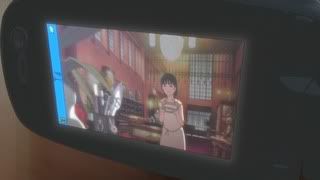
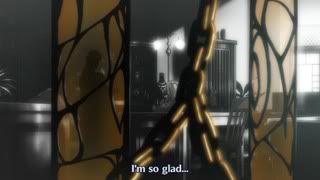
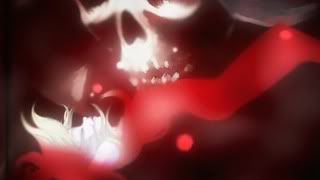
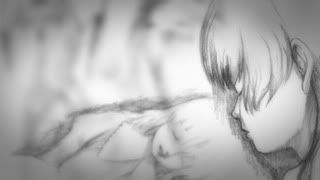
All the negative reviews of Le Portrait de Petit Cossette (Cossette no Shouzou) that I'd read made me hesitant to watch it, but I thought I'd give it a try after Martin of Mono no Aware listed it in his top 50 anime made since 2000 at number 23, saying: This was my first encounter with Akiyuki Shinbo’s unique directorial style, and although it’s a case of making the simple obtuse from a narrative standpoint it’s still an impressive visual tour-de-force (who’s misusing French now?). The gothic aesthetic, porcelain doll heroine and that goosebump-inducing Yuki Kajiura music score really make it worthwhile for me.
While I'd already seen parts of Sayonara Zetsubou Sensei, Ef, and Bakemonogatari, I'd seen them (and Le Portrait de Petit Cossette) without realizing that they were under the same director. Now it all makes sense. Well, it doesn't all make sense. But it does explain a lot.
Le Portrait de Petit Cossette is a three episode series about a French girl named Cossette from the 18th century whose fiance Marcelo kills her in an attempt to preserve her beauty. Her spirit is then trapped in a collection of antique glass. In modern day Japan, an art student named Eiri is wroking at an antique shop. He eventually becomes aware of Cossette's presence and falls in love with her. She tells him that he is the reincarnation of Marcelo Orlando, and that if he loves her, he must let her punish him for Marcelo's sins. Eventually, we discover that there are two Cossettes-- the Cossette of Marcelo's picture and the true spirit of Cossette. Unable to bear subjecting Eiri to the pain of Marcelo's sins, the real Cossette banishes herself to a portrait in Marcelo's atelier (in her dream world, it is hard to explain hahah), and the portrait Cossette attempts to enslave Eiri to paint portraits of her forever. At the end of the series, Eiri paints a picture of the real Cossette in blood, freeing her spirit at last.
Le Portrait de Petit Cossette's major selling point for me was its incredibly striking and fragmented visuals that more than once reminded me of Studio Shaft, which incidentally is the studio that Akiyuki Shinbo usually works under. Some examples?
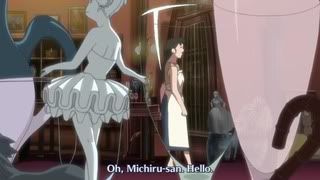
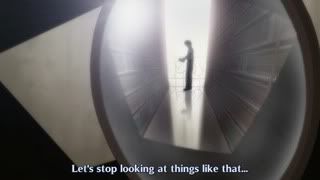
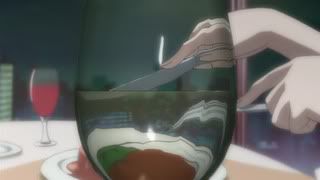
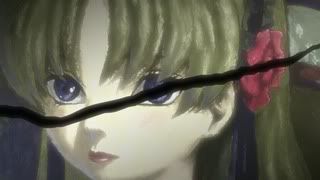
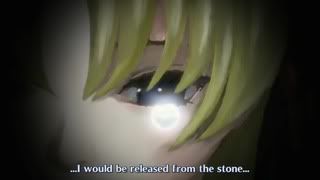
- The continued use of sight-- floating eyeballs, pictures of doodles of eyes, the strangers who see the scenes reflected in their sunglasses, constant close-ups of characters' eyes, the way we repeatedly see things refracted in wine glasses, water, the fact that Cossette's portrait cracks along a line straight through her left eye. We are constantly be told to question what we see and what we don't see.
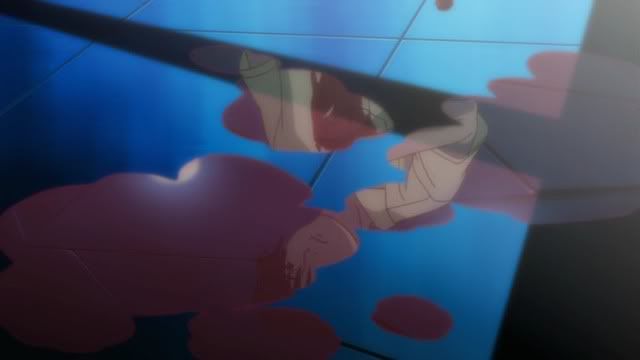
- Similarly, in the second episode, when Eiri faces Shoko, you see his face finally revealed.... in a pool of blood.
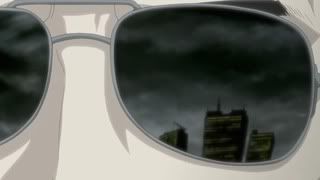
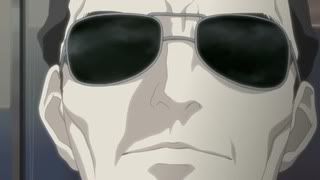
- The moon? Drop of water? we see in the first moments of episode one lingers like a suspended eyeball in Cossette's eye, then drops like a tear down her face, and then the first time we are given context for where we are (modern day somewhere), it is, yes, a reflection in someone's sunglasses.
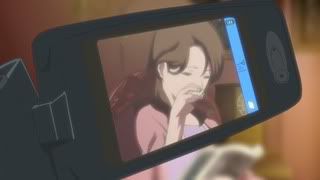
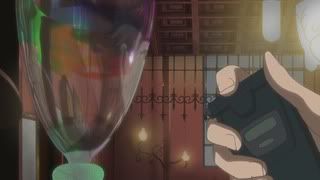
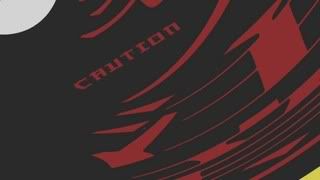
- Actually, much of the first episode is incredibly rich in the way it plays with sound and image. As expected of a Shaft director, I guess! For instance, the muted conversation Eiri has in the Japanese garden, or that early on Zennishi tells us her father's spirit rests in a sake bottle, or Eiri using his cell phone (his cell phone!) to film through the Venetian glass in an attempt to catch a ghost from hundred of years ago. The way we get ever nearer to the caution sign as Eiri picks up the Venetian glass.
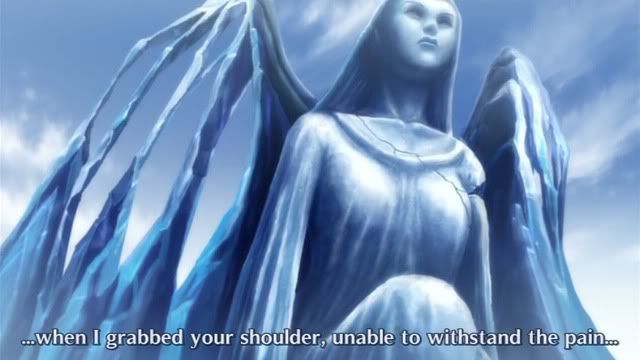
- That moment where Eiri in the second episode talks to Cossette and they understand each other's pain for the first time, the stone statue of the woman looks to have both angel and skeletal bat wings. It was such a great crystallization of the dual nature of Cossette, and just a few seconds of it too. The motif is never used again.
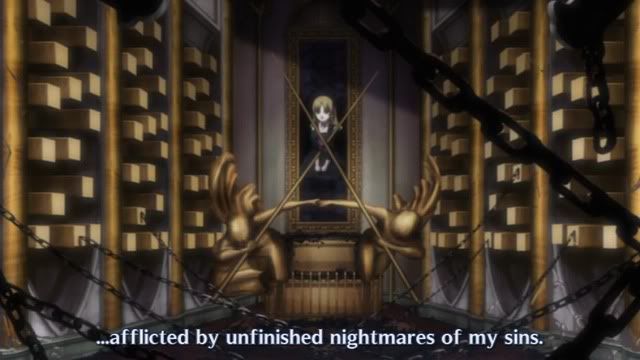
- In episode three, we are given a portrait of Cossette, but she is flanked by a bronze statue of two children? angels? who hold spears in a cross position that just perfectly intersect Cossette at her neck, so it looks from far away as if she is being held at spear point. Because, and this is what we don't know as an audience yet, she is still in her death, being held at spear point.
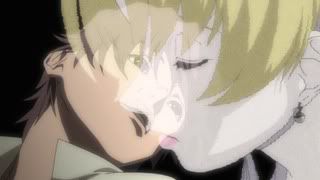
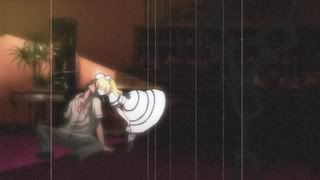
- When Cossette kisses Eiri, at first you see merely her layered image on Eiri's face before you actually see that her ghost really is kissing him.
- If you notice, all three episodes have a final scene between Cossette and Eiri that seems to signify they've come to some understanding or peace. They do, in a way, but the first two understandings are false starts. It's only the last one that's real, and we know that because while episodes one and two zoom in at the end on a portrait of Cossette as drawn by Marcelo, the third episode zooms in on the blood portrait drawn by Eiri.
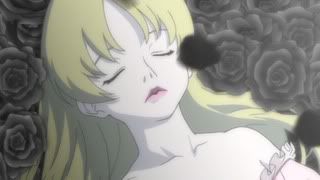
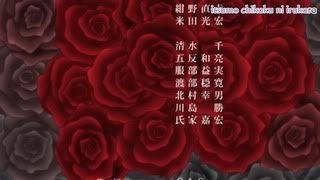
- The roses that Cossette's body lies on, at first you think they are just shadowed so they are black, but eventually you realize they are actually black. Because the final portrait of Cossette is in blood, and you know it will eventually oxidize until it is darker and darker, it is like that painting is giving the roses back their color. Or, as the final credit sequence reveals, it is like Eiri is bleeding himself to color the roses of Cossette's burial.
Some of the questions commonly asked about this series in reviews are easily answered, I think, if you merely let yourself be absorbed by the series, instead of setting out to question it. Like, how does Cossette understand Japanese or Eiri understand French? They don't. They're just communicating in their hearts. Probably to Cossette she hears him speak in French, and Eiri hears her in Japanese. Why is the story told in such a fragmented, confusing way? Probably because to Eiri, the story is confusing. For no reason at all, for no reason of his choosing, he is selected by a creepy French ghost who tells him he is the reincarnation of her killer and also that he must atone for sins that he didn't commit. When we do venture into her world, we are conscious that it's not her world at all; rather we are in fantasy world created of her memories, emotions, the after life, and her will manipulating the fabric of all these things. How can that not be confusing?
There's a wonderful sort of dream logic about everything in this series. Like, of course the Cossette in the portrait and the Cossette who is a true ghost are two different people who both insist that they are the real Cossette. Of course Marcelo's soul in Eiri is portrayed as a beast, a beast that Eiri only rids himself of after he crushes his metaphorical heart in his hands and bleeds himself to draw a picture of her. Of course it is the glass objects that witnessed Cossette's death that hold a grudge, not Cossette herself. Of course it is the living girl, Shoko, who takes Eiri out of the world of the dead, like some sort of gender-reversed Orpheus.
But there are issues rightly brought up about Le Portrait de Petit Cossette. For one, why are all the secondary characters, which consist of like five women, given absolutely no backstory or development? Why are so many of Eiri's closer acquaintances female anyway? Who are the people we keep seeing with sunglasses on who watch Eiri and his friends? Why does Shoko go into a coma? Why does the final portrait Eiri create of Cossette free her of the portrait ghost? And why, or rather, how is Shoko in the world of Cossette and Eiri anyway? Is it because of what Eiri says, that all things that are pure eventually become one? And is that really Shoko at the end, or is it Cossette in Shoko, like some people claim? And if that's Cossette being reborn, where did Shoko's soul go? It's almost like none of the other characters, besides Eiri and Cossette, even matter.
But I guess, too, the answers to these questions are overwhelmed by the point of the series, which is to be lovely and gothic and visually stimulating with a beautiful Yuki Kajiura soundtrack. For a three episode series, it does well with what it has. It's a story ultimately about beauty and art, about the relationship between the model and the artist, and how that intersects with love, and you know what, Le Portrait de Petit Cossette did that part pretty well. It in fact managed to handle those themes better than that horrific remake of The Picture of Dorian Gray, starring Bin Bons. Perhaps, in the end, only Eiri and Cossette matter because to them, as the artist and the subject, they are the only ones that are real to each other. The story was created for them and for no one else. We, and Yuu and Shoko and Michiru and Zenshinni and the others, are no more important than the sunglasses of those casual observers. We can't affect anything. We can only watch and reflect.
Also, re: on the topic of past lives and reincarnation, there's a whole essay I should write here about Homunculus and After School Nightmare and the very different and very similar ways they handle questions of determination and true selves. Let's just pretend it's here, okay?